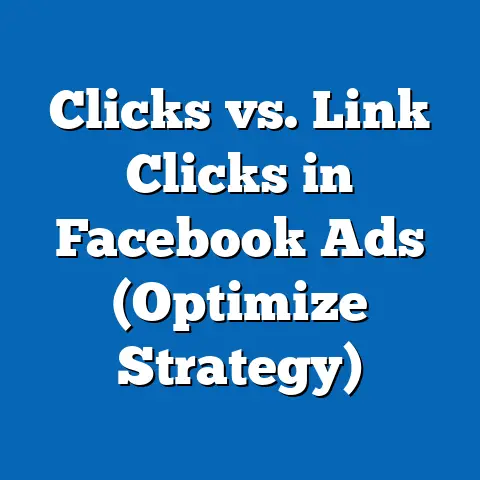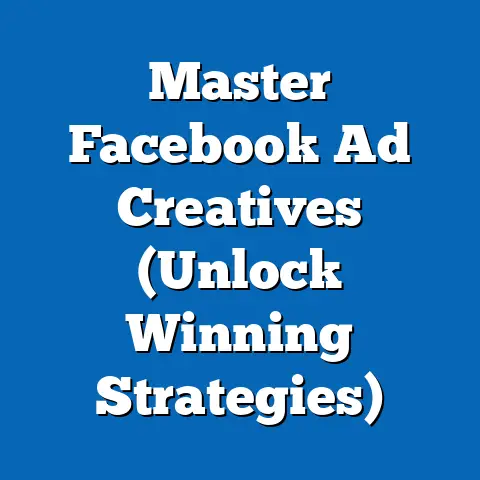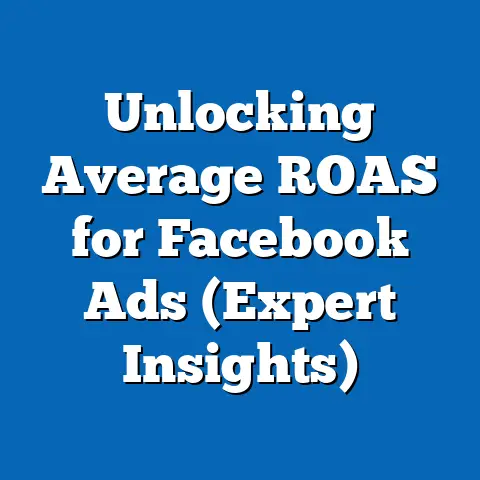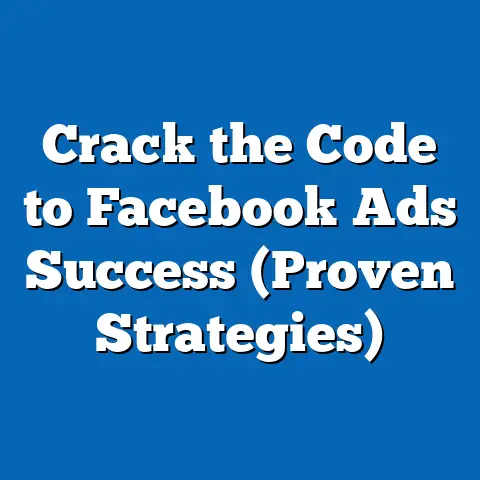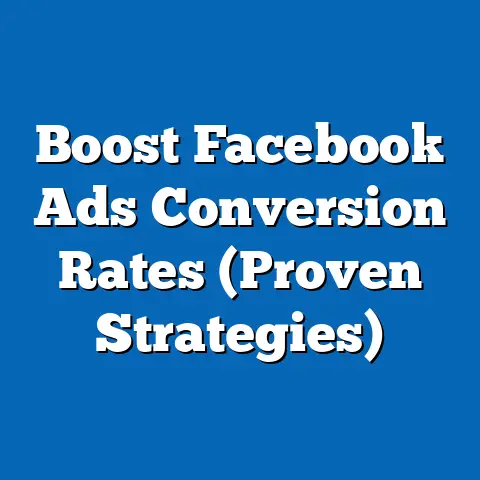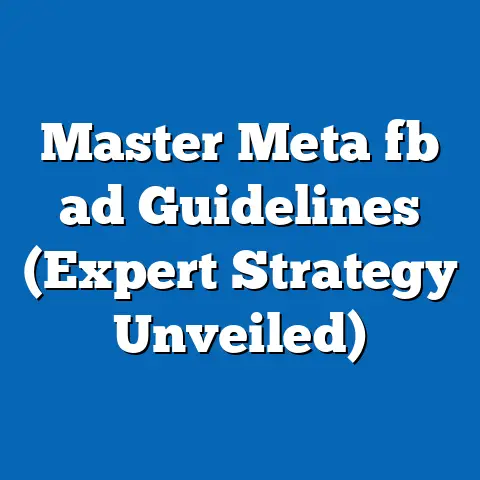Craft Ads that Convert (Pro Strategies for Facebook)
Facebook advertising, when done right, can be a game-changer for businesses. I’ve seen firsthand how a well-crafted ad campaign can skyrocket brand awareness, drive sales, and cultivate a loyal customer base. According to recent studies, Facebook ads can increase brand awareness by up to 80% among targeted audiences. That’s a huge potential impact, but only if you know how to harness the power of the platform. In this guide, I’ll share the pro strategies I’ve learned over years of managing Facebook ad campaigns, helping you create ads that not only grab attention but also drive conversions.
Understanding the Facebook Advertising Ecosystem
Facebook’s advertising ecosystem is a dynamic and powerful tool for businesses of all sizes. It’s no longer just about throwing an ad out there and hoping for the best. It’s about strategic targeting, compelling creative, and continuous optimization.
The Current Landscape
Today, Facebook boasts billions of active users, making it a prime platform for reaching a vast and diverse audience. But with that reach comes complexity. The platform has become increasingly sophisticated, with advanced targeting options, diverse ad formats, and a constantly evolving algorithm.
I remember when Facebook ads were simpler – a basic image and some text. But now, we have video ads, carousel ads, collection ads, and more, each with its own unique strengths and potential.
The Evolution of Facebook Ads
Facebook ads have evolved significantly since their inception. Initially, they were primarily focused on simple brand awareness. Now, they’re geared toward driving specific actions, from website visits to lead generation to direct sales.
This evolution mirrors the changing consumer behavior. People are more savvy, more discerning, and more easily distracted. To capture their attention, you need ads that are not only visually appealing but also highly relevant and personalized.
The Power of Targeting
One of Facebook’s greatest strengths is its unparalleled targeting capabilities. You can target users based on demographics, interests, behaviors, and even their connections. This allows you to reach the right audience with the right message at the right time.
I once worked on a campaign for a local bakery. By targeting users who were interested in baking, cooking, and local food, we were able to generate a significant increase in foot traffic to their store. That’s the power of precise targeting!
Key Takeaway: Facebook advertising is a powerful tool, but it requires a strategic approach. Understanding the current landscape, the evolution of ads, and the power of targeting is crucial for success.
The Anatomy of a High-Converting Facebook Ad
Creating a high-converting Facebook ad is like crafting a perfect dish – it requires the right ingredients and the right execution. Here’s a breakdown of the key components:
Visuals: The First Impression
Your visual is the first thing people see, so it needs to grab their attention instantly. High-quality images or videos are essential.
- Image Dimensions: Ensure your images meet Facebook’s recommended dimensions (currently 1200 x 628 pixels for most ads).
- Format: Experiment with different formats, such as images, videos, and GIFs. I’ve found that video ads often outperform static images, especially for showcasing products or services in action.
- Relevance: Make sure your visual is relevant to your product or service and appeals to your target audience.
- Pro Tip: Use bright colors, clear imagery, and compelling visuals that stand out in the newsfeed.
Ad Copy: Telling Your Story
Your ad copy is your chance to tell your story and persuade people to take action.
- Headline: Your headline should be concise, attention-grabbing, and relevant to your offer. Use strong verbs and create a sense of urgency or curiosity.
- Body Text: Your body text should expand on your headline and highlight the benefits of your product or service. Keep it short, sweet, and to the point.
- Value Proposition: Clearly communicate your value proposition – what makes your product or service unique and why should people choose you over the competition?
- Pro Tip: Use power words (e.g., “free,” “new,” “exclusive”) to make your copy more persuasive.
Call-to-Action (CTA): Guiding the User
Your call-to-action tells people what you want them to do next.
- Clear and Concise: Your CTA should be clear, concise, and action-oriented.
- Relevance: Choose a CTA that is relevant to your campaign goal. For example, if you want people to visit your website, use “Learn More.” If you want them to make a purchase, use “Shop Now.”
- Urgency: Create a sense of urgency by using phrases like “Limited Time Offer” or “Shop Now Before It’s Too Late.”
- Pro Tip: A/B test different CTAs to see which ones perform best.
I’ve seen many ads fail simply because the CTA was weak or unclear. A strong CTA can make all the difference!
Key Takeaway: A high-converting Facebook ad is a combination of compelling visuals, persuasive ad copy, and a clear call-to-action. Each element plays a crucial role in driving conversions.
Targeting the Right Audience
Targeting is the key to unlocking the full potential of Facebook advertising. You can have the most beautiful ad in the world, but if it’s shown to the wrong people, it’s not going to convert.
Demographic, Geographic, Psychographic, and Behavioral Targeting
Facebook offers a wide range of targeting options, allowing you to reach specific segments of the audience.
- Demographic Targeting: Target users based on age, gender, education, job title, and other demographic information.
- Geographic Targeting: Target users based on their location, from country to city to zip code.
- Psychographic Targeting: Target users based on their interests, hobbies, and lifestyle.
- Behavioral Targeting: Target users based on their online behavior, such as purchase history, website visits, and app usage.
I once ran a campaign for a luxury travel agency. By targeting users who were interested in luxury travel, high-end hotels, and fine dining, we were able to generate a significant number of high-quality leads.
Creating Buyer Personas
Creating buyer personas is a crucial step in the targeting process. A buyer persona is a fictional representation of your ideal customer.
- Research: Conduct research to gather information about your target audience, such as their demographics, interests, pain points, and goals.
- Segmentation: Segment your audience into different buyer personas based on their characteristics and behaviors.
- Personalization: Tailor your ads to each buyer persona, using language, visuals, and offers that resonate with them.
Custom Audiences and Lookalike Audiences
Custom Audiences and Lookalike Audiences are powerful tools for maximizing ad reach and effectiveness.
- Custom Audiences: Create custom audiences based on your existing customer data, such as email lists, website visitors, and app users.
- Lookalike Audiences: Create lookalike audiences based on your custom audiences. Facebook will identify users who share similar characteristics with your existing customers.
I’ve found that Lookalike Audiences often outperform other targeting options, as they allow you to reach new customers who are likely to be interested in your product or service.
Key Takeaway: Effective targeting is essential for Facebook advertising success. By leveraging demographic, geographic, psychographic, and behavioral targeting, creating buyer personas, and utilizing Custom Audiences and Lookalike Audiences, you can reach the right audience with the right message.
Leveraging A/B Testing for Optimization
A/B testing, also known as split testing, is the process of comparing two versions of an ad to see which one performs better. It’s a crucial component of any successful Facebook advertising strategy.
The Importance of A/B Testing
A/B testing allows you to make data-driven decisions about your ad campaigns. Instead of relying on guesswork, you can test different elements of your ads and see what works best for your audience.
I’ve seen firsthand how A/B testing can significantly improve ad performance. Even small changes can have a big impact.
Setting Up A/B Tests
Here’s a step-by-step guide on how to set up A/B tests on Facebook:
- Choose an Element to Test: Identify the element of your ad that you want to test, such as the headline, image, or CTA.
- Create Two Versions: Create two versions of your ad, each with a different variation of the element you’re testing.
- Set Up Your Campaign: Set up your campaign in Facebook Ads Manager, targeting the same audience for both versions of your ad.
- Monitor Results: Monitor the performance of both versions of your ad, tracking key metrics such as click-through rate (CTR), conversion rate, and cost per acquisition (CPA).
- Analyze Data: Analyze the data to determine which version of your ad performed better.
- Implement Changes: Implement the winning variation in your ad campaigns.
What to Test
Here are some elements you can test:
- Visuals: Test different images, videos, and GIFs.
- Headlines: Test different headlines to see which ones grab attention.
- Body Text: Test different body text to see which ones resonate with your audience.
- CTAs: Test different CTAs to see which ones drive conversions.
- Targeting: Test different targeting options to see which audiences are most responsive.
Interpreting Results
It’s crucial to understand how to interpret the results of your A/B tests.
- Statistical Significance: Ensure that your results are statistically significant before making any decisions.
- Key Metrics: Focus on the key metrics that are most relevant to your campaign goals.
- Continuous Testing: A/B testing is an ongoing process. Continuously test different elements of your ads to optimize performance.
Key Takeaway: A/B testing is a powerful tool for optimizing your Facebook ad campaigns. By testing different elements of your ads and analyzing the results, you can make data-driven decisions that improve performance.
Budgeting and Bidding Strategies
Setting the right budget and choosing the right bidding strategy are crucial for maximizing your ROI on Facebook advertising.
Budgeting Options
Facebook offers two main budgeting options:
- Daily Budget: Set a daily budget for your ad campaign. Facebook will spend approximately this amount each day.
- Lifetime Budget: Set a lifetime budget for your ad campaign. Facebook will spend this amount over the duration of the campaign.
I recommend using a daily budget for ongoing campaigns and a lifetime budget for campaigns with a specific end date.
Bidding Strategies
Facebook offers several bidding strategies:
- Cost Per Click (CPC): Pay for each click on your ad.
- Cost Per Impression (CPM): Pay for every 1,000 impressions of your ad.
- Cost Per Action (CPA): Pay for each specific action, such as a website visit or a purchase.
Choosing the right bidding strategy depends on your campaign goals. If you want to drive traffic to your website, CPC is a good option. If you want to increase brand awareness, CPM is a better choice. If you want to drive specific actions, CPA is the way to go.
Monitoring Ad Performance
It’s crucial to monitor your ad performance and adjust your budgets accordingly.
- Track Key Metrics: Track key metrics such as CTR, conversion rate, and CPA.
- Adjust Bids: Adjust your bids based on the performance of your ads.
- Optimize Targeting: Optimize your targeting to reach the most responsive audience.
Key Takeaway: Setting the right budget and choosing the right bidding strategy are essential for maximizing your ROI on Facebook advertising. Monitor your ad performance and adjust your budgets accordingly to optimize results.
Measuring Success and Analyzing Results
Tracking key performance indicators (KPIs) and analyzing results is crucial for understanding the effectiveness of your Facebook ad campaigns.
Key Performance Indicators (KPIs)
Here are some key performance indicators (KPIs) to track:
- Click-Through Rate (CTR): The percentage of people who click on your ad after seeing it.
- Conversion Rate: The percentage of people who take a desired action (e.g., make a purchase, sign up for a newsletter) after clicking on your ad.
- Cost Per Acquisition (CPA): The cost of acquiring a new customer through your ad campaign.
- Return on Ad Spend (ROAS): The amount of revenue generated for every dollar spent on your ad campaign.
Facebook Ads Manager
Facebook Ads Manager is a powerful tool for tracking and analyzing your ad performance.
- Real-Time Data: Access real-time data on your ad campaigns.
- Customizable Reports: Create customizable reports to track the metrics that are most important to you.
- Performance Insights: Gain insights into the performance of your ads, such as which ads are performing well and which ones need improvement.
Analyzing Data
Analyzing your data is crucial for identifying trends, successes, and areas for improvement.
- Identify Trends: Look for trends in your data to understand what’s working and what’s not.
- Celebrate Successes: Celebrate your successes and learn from your mistakes.
- Continuous Improvement: Continuously analyze your data and make improvements to your ad campaigns.
Key Takeaway: Tracking key performance indicators (KPIs) and analyzing results is crucial for understanding the effectiveness of your Facebook ad campaigns. Use Facebook Ads Manager to track your performance and identify areas for improvement.
Staying Ahead of Trends and Best Practices
The world of Facebook advertising is constantly evolving. To stay ahead of the curve, you need to stay updated with the latest trends and best practices.
Current Trends
Here are some current trends in Facebook advertising:
- Video Content: Video content is becoming increasingly popular on Facebook.
- Storytelling: Storytelling is a powerful way to connect with your audience.
- Interactive Ads: Interactive ads, such as polls and quizzes, are becoming more popular.
Facebook Advertising Policies
It’s crucial to stay updated with Facebook’s advertising policies.
- Review Policies: Regularly review Facebook’s advertising policies to ensure that your ads comply with the rules.
- Avoid Violations: Avoid violating Facebook’s advertising policies, as this can result in your ads being disapproved or your account being suspended.
Algorithm Changes
Facebook’s algorithm is constantly changing.
- Stay Informed: Stay informed about the latest algorithm changes and how they may impact your ad campaigns.
- Adapt Strategies: Adapt your strategies to the latest algorithm changes to maintain your ad performance.
Key Takeaway: Staying ahead of trends and best practices is crucial for maintaining a competitive edge in the ever-evolving landscape of Facebook ads. Stay updated with the latest trends, Facebook’s advertising policies, and algorithm changes.
Conclusion
Facebook advertising offers incredible potential for businesses to reach their target audience, drive conversions, and achieve their business goals. By understanding the Facebook advertising ecosystem, crafting high-converting ads, targeting the right audience, leveraging A/B testing, budgeting effectively, measuring success, and staying ahead of trends, you can elevate your Facebook advertising efforts and achieve remarkable results.
Now, it’s your turn to implement these pro strategies and start crafting your own high-converting Facebook ads. Share your experiences and results in the comments section or on social media. Let’s work together to unlock the full potential of Facebook advertising!

